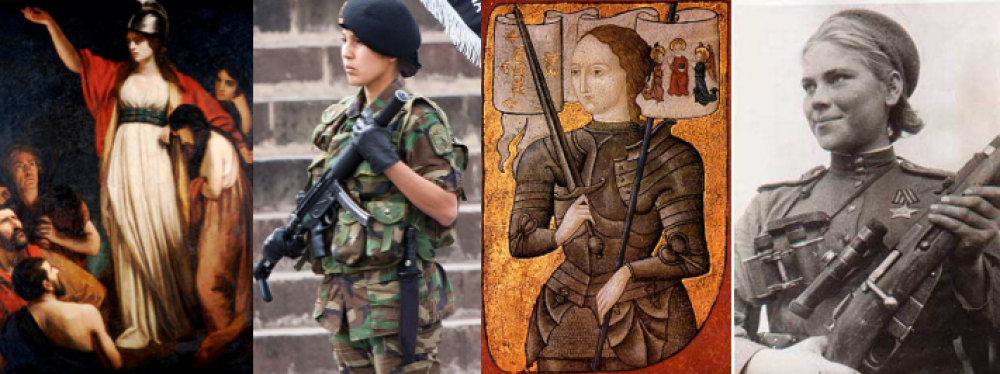For as long as people have fought one another, men have dominated the role that is a soldier. Women have always been present during wartimes, serving chiefly as nurses or medics. However, throughout history, in legend and reality, women have been present in combat. Many famous female leaders have been involved in military combat and action. One may even consider that women have had to sacrifice and shed their femininity and accept masculine qualities in order to fight beside men.
Women in war have been thoroughly represented in works of fiction and popular culture. For instance, Hua Mulan was a famous, legendary female warrior who went to war against the Huns, disguised as a man and in her father’s place in order to save him. She was made popular by the Disney movie Mulan, but her story originates from ancient china is a poem known as the Ballad of Mulan. Another famous female warrior was Joan of Arc. Joan of Arc is a folklore heroine of France. She was born a peasant and lived to lead the French army to several victories in the Hundred Years’ War, a series of conflicts between England and France. Her actions allowed for coronation of King Charles VII. Joan met her death when the English burned her at the stake for insubordination and heresy. Women in war and combat has always been a rare thing, which explains its popular presence in fiction, but has become more and more frequent as women have gained greater equality with men.
Just as women have been perceived in war fictionally, women have been found partaking in war and combat of reality. A Gladiatrix, although a rarity and novelty, was a female gladiator during the rule of the Roman Empire. Gladiatrices were the female counterparts of Roman gladiators and were most popular under the rule of Nero. They usually fought bare-chested and without helmets. Additionally, women have known to spearhead wars and lead people to battle. For instance, Artemisia of Caria, best known for her skilled naval tactics, was the queen of the city Halicarnassus during the 5th Century BCE. She led a fleet of five ships to attack the Greeks with the Persian king, Xerxes, during the Battle of Salamis. Another was Boudicca, Queen of the British Iceni Tribe. When her husband died, he left his kingdom to his daughters and also to the Roman Empire. However, the Romans took full control, beat Boudicca, and raped her daughters. In turn, Boudicca lead the Iceni people against the Romans along with other tribes, destroying cities and temples conquered by the Romans and defeating several legions of Roman soldiers. Although Boudicca was defeated in the Battle of Walting Street, she became an important legendary figure during the Renaissance and Victorian Era. These women successfully exhibit the women in war, historically, and the ability some women had to affect the people and move past traditional female roles of society.
However, what have women done or changed in order to take on the dominantly male environment of war? Consistently it seems, women have had to sacrifice and shed their femininity and accept masculine qualities in order to fight beside men. Many women have disguised themselves as men, forsaking their femininity in order to fight for a cause. Deborah Sampson was one of a small number of American women, who dressed as a man in order to fight in the American Revolutionary war. When drafted in the war, she took the name Robert Shurtliff. It can be argued that all women who choose to fight in battle have followed the same trend of feigning masculinity and adapting to suit the masculine environment of war. Although they do not always pretend to be men, women leave behind the roles and expectations that society holds for all women. Jeanne de Clisson, also known as the Lioness of Brittany, was a feared British pirate who dressed as a man and plundered French ships as revenge against King Phillip VI for executing her husband. She was known to personally behead the French aristocrats that she captured with an axe. Bravery and strength have always been seen as a masculine quality. By participating in war and combat, women have relinquished many feminine traits, taking on masculine ones instead.
Additionally, women’s involvement in military has been a rare and controversial subject in society. Some complaints against women include a belief that women are a distraction because men may feel the need to protect women or have a sexual attraction to women. Others argue that women cannot be trusted and worry that they would ruin the esprit de corps, which is the capacity for a group of soldiers and its members to maintain a belief in their mission, objective, and hardship. Many also believe that women do not easily intimidate the enemy and that people will not surrender to women. People also do not want to risk women in the military being captured and tortured. Lastly, within the same military, women have a high risk of being raped and sexually assaulted by one of their own, which leads to serious internal conflict and problems. Men have commanded and controlled military matters throughout history because, genetically, men tend to be stronger and better fit for combat. Women’s involvement in military is different for these reasons can be unwelcomed. Although, compared with women of the past, women today have a been seen to more frequently partake in military affairs.
